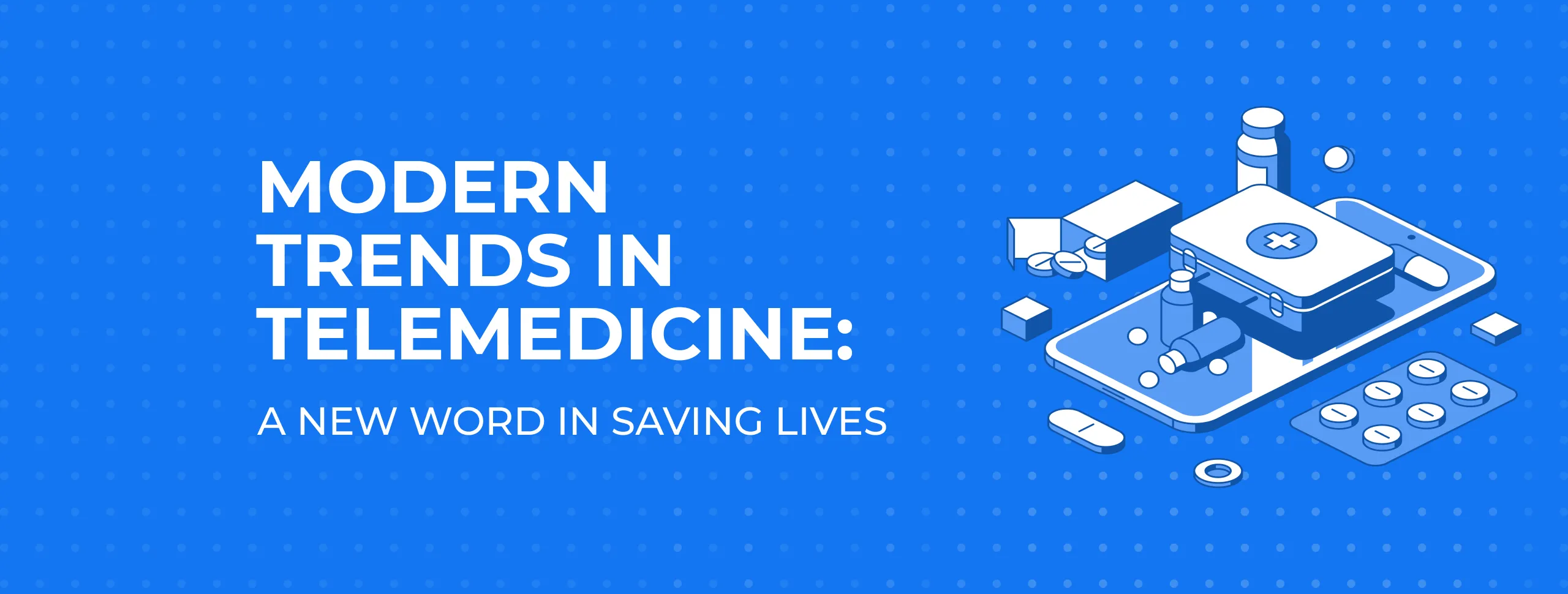
Modern Trends in Telemedicine: a New Word in Saving Lives

The world telemedicine market is expected to reach USD 113.1 billion by 2025 and is clearly a market with great potential.
Some of the pioneers are already there, implementing new technologies on the spot. Here we’ll discuss some of the telemedical revelations.
What is telemedicine?
Telemedicine is the practice of taking care of patients from a distance. Thus, there is no need for either a doctor or the patient to be physically patient. With the help of contemporary technologies, physicians can now consult with their patients via HIPAA-compliant video call tools and telemedicine software.
Pulse, temperature and pressure, as well as other measurements, can be easily tracked via smart devices.
Such technological solutions benefit the patients since they no longer have to visit the clinic to get their medical test results or wait in long queues to see a doctor.
- Each businessman or woman can connect to their doctor directly from the office and the critical statement can be predicted remotely.
- For elderly patients, it’s a huge step forward to be able to age with more comfort and dignity at home with the necessary healthcare and related monitoring.
- Telemedical opportunities spare personnel from travelling back and forth to provide a standard check-up and allows them to take care of more patients within the same period of time.
Top trends in healthcare
1. Virtual caregiving
This kind of personal assistant powered by AI can analyse different parameters in order to allow older patients to age safely in their homes with proper care.
- One of them, Addison, is already being used in the USA by more than 10,000 people, and this number is expected to continue to grow.
- The electronic caregiver looks like a fitness wrist bracelet that monitors and records different health measurements.
- It also provides the option of receiving voice messages and medicine taking reminders. It has pocket MD (medical doctor) and can connect the patient to the doctor or emergency care personnel any time they need.
What this accessory does is make up for an insufficient number of caregiving professionals, making healthcare more affordable and thus bringing it closer to people.
2. Telemedicine saving lives in remote locations
There are still places on Earth that are inaccessible to medical staff to provide constant physical medical healthcare. Telepatients, with the help of an internet connection and smart devices, can communicate with their GPs at any time and are under constant monitoring. This frees the doctors from travel to such remote locations.
A list of the best telemedical healthcare apps can be found here.
3. Patient Data Collection and Data Analytics
- Even if you don’t have any serious illnesses, constant monitoring will help you to avoid crucial stress and overwork. Usage of big data algorithms to analyse the information you provide via body trackers will automate the health-monitoring process and inform you of the necessity to take a break, as well as providing the medical staff with some crucial updates.
4. Mobility and Cloud Access
Hospitals, clinics and insurance companies now store all their patients’ data in a cloud. This makes statistical information highly accessible. Data can be used for analysis from any mobile or desktop device that has the necessary app installed.
- 1 in 5 physicians currently uses telehealth IT in their work, according to a new survey from telehealth company American Well. By 2022, they expect more than 61% of physicians who have not yet adopted telecare technologies to start utilising them. Among those doctors who have already experienced video visits, 15% use it two or more times a week – a figure that is likely to grow to 50% by 2022.
Aside from distance checkups, doctors also use apps to keep patients’ records for consultations and processing of their data. Clinics publish medical test results online, which eliminates the necessity to come to the clinic to stand in queues. Professionals report that these technological means protect them from burnout, allowing them to provide improved care access to patients.
5. AR/VR to treat dementia
As research shows, these technologies can help people suffering from Alzheimer's and other degenerative diseases restore their memories. This has a positive effect on their mood and general well-being – however, the full potential of AR/VR in medicine is yet to be discovered.
6. Artificial Intelligence for diagnosis
AI solutions are much better at finding patterns than humans. This makes them extremely effective in medical diagnosis. For example, here is the case of AI that diagnosed a child’s illness faster and with a higher degree of accuracy than experienced doctors. Large Language Models (LLMs) are transforming telemedicine by enhancing diagnostic accuracy, streamlining patient interactions, and personalizing care. These advanced models analyze vast amounts of medical data, identifying patterns that improve diagnostic precision and support informed decision-making. They also facilitate smoother patient interactions by understanding natural language queries and handling routine tasks, which alleviates the workload for healthcare providers.
7. Enhanced Security: Blockchain
Since a lot of confidential medical data is now stored in the cloud, it’s vital to improve security measures. Cryptographic encryption of data with blockchain technology, as well as strictly controlled implementation of GDPR and regular safety tests, is a must for any telemedicine development project.
Investment in telemedicine: public gratitude and great potential
Telemedicine has a leading position on the digital market today. For example, 60% of millennials are already willing to introduce telehealth checks into their daily routine.
If you choose to invest in this kind of development, you will be contributing to the improvement of people’s lives and likely to make a good profit on a highly sought-after project.





